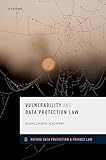Vulnerability and data protection law / Gianclaudio Malgieri, Leiden University.
Material type: TextSeries: Oxford data protection & privacy law | Oxford data protection and privacy lawPublisher: Oxford, United Kingdom : Oxford University Press, 2023Edition: First editionDescription: xxvi, 271 pages ; 24 cmContent type:
TextSeries: Oxford data protection & privacy law | Oxford data protection and privacy lawPublisher: Oxford, United Kingdom : Oxford University Press, 2023Edition: First editionDescription: xxvi, 271 pages ; 24 cmContent type: - text
- unmediated
- volume
- 9780192870339
- Oxford data protection and privacy Law [Added title page title]
- 23rd 342.0858 MAL
- K3264.C65 M35 2023
| Item type | Current library | Collection | Call number | Copy number | Status | Notes | Date due | Barcode | |
|---|---|---|---|---|---|---|---|---|---|
| Reference Book | VIT-AP LAW Section | Reference | 342.0858 MAL (Browse shelf(Opens below)) | LA02697 | In transit from VIT-AP to VIT AP School of Law since 2024-08-08 Not For Loan | LAW | 021918 | ||
| Text Book | VIT-AP LAW Section | 342.0858 MAL (Browse shelf(Opens below)) | LA02698 | In transit from VIT-AP to VIT AP School of Law since 2024-08-08 | LAW | 021919 |
Includes bibliographical references (pages 239-257) and index.
Table of Contents :
1:Introduction: The reasons for research on data subjects
2:The notion of data subject: an average individual?
3:Who is the vulnerable individual?
4:The vulnerable data subject in the GDPR
5:Data protection principles and vulnerable data subjects
6:Data protection rights and duties and vulnerable data subjects
7:Assessing (and mitigating) layers of data subjects' vulnerability: Using the DPIA as a Model
8:The limitations and the alternatives of a vulnerability-based interpretation of the GDPR
9:Conclusions: The layers of data subject's vulnerability and the way ahead
Description:
Vulnerability has traditionally been viewed through the lens of specific groups of people, such as ethnic minorities, children, the elderly, or people with disabilities. With the rise of digital media, our perceptions of vulnerable groups and individuals have been reshaped as new vulnerabilities and different vulnerable sub-groups of users, consumers, citizens, and data subjects emerge.
Vulnerability and Data Protection Law not only depicts these problems but offers the reader a detailed investigation of the concept of data subjects and a reconceptualization of the notion of vulnerability within the General Data Protection Regulation. The regulation offers a forward-facing set of tools that-though largely underexplored-are essential in rebalancing power asymmetries and mitigating induced vulnerabilities in the age of artificial intelligence.
Considering the new risks and potentialities of the digital market, the new awareness about cognitive weaknesses, and the new philosophical sensitivity about the condition of human vulnerability, the author looks for a more general and layered definition of the data subject's vulnerability that goes beyond traditional labels. In doing so, he seeks to promote a 'vulnerability-aware' interpretation of the GDPR.
A heuristic analysis that re-interprets the whole GDPR, this work is essential for both scholars of data protection law and for policymakers looking to strengthen regulations and protect the data of vulnerable individuals.
There are no comments on this title.

